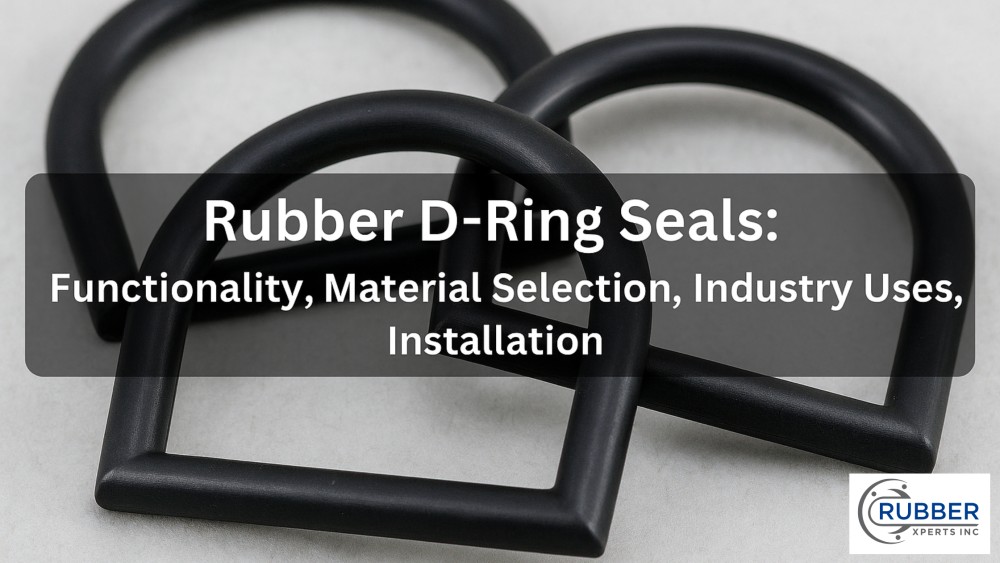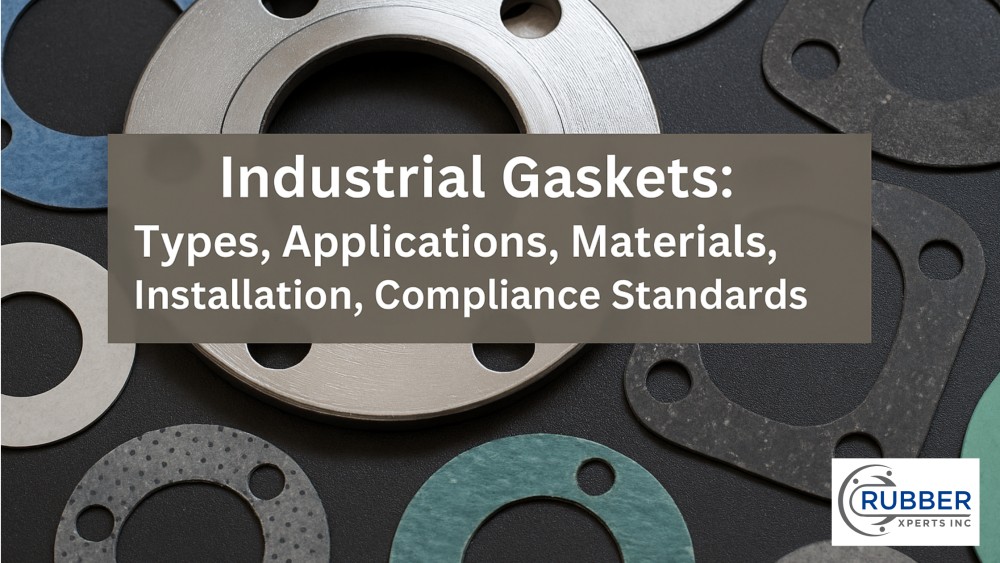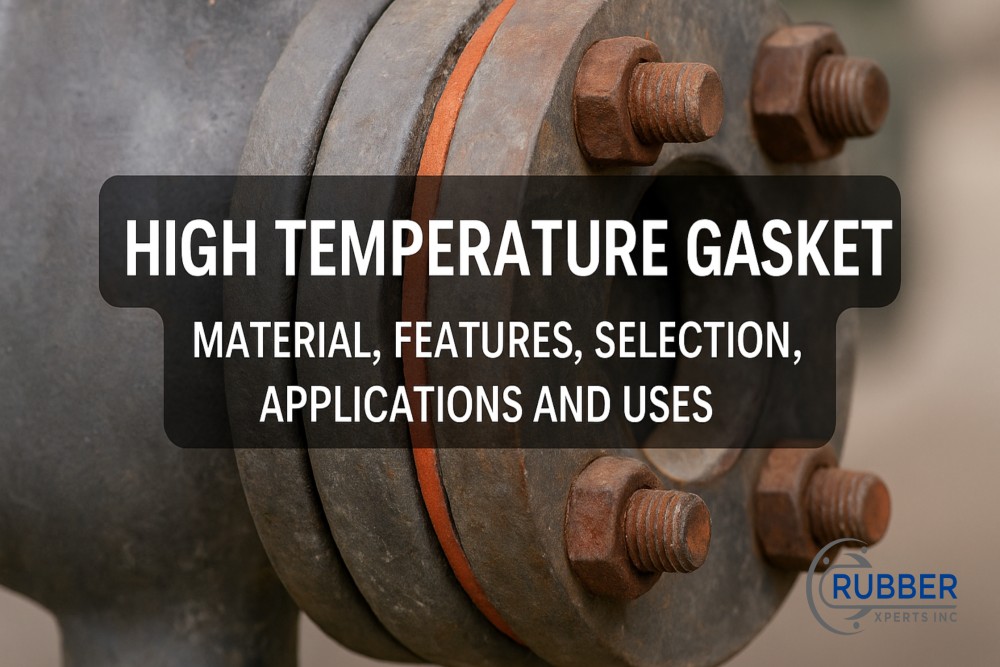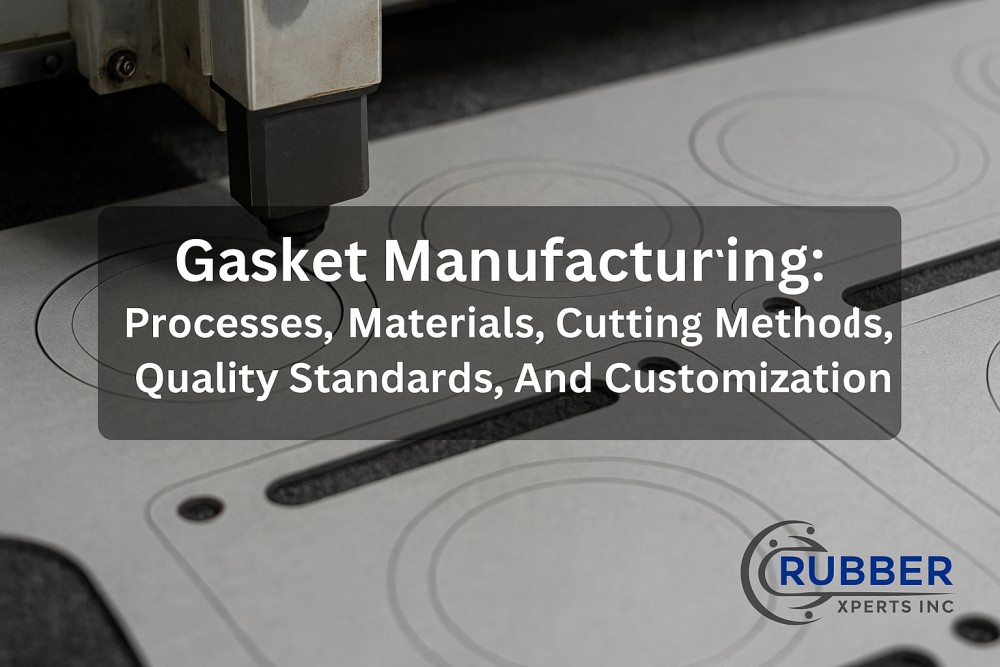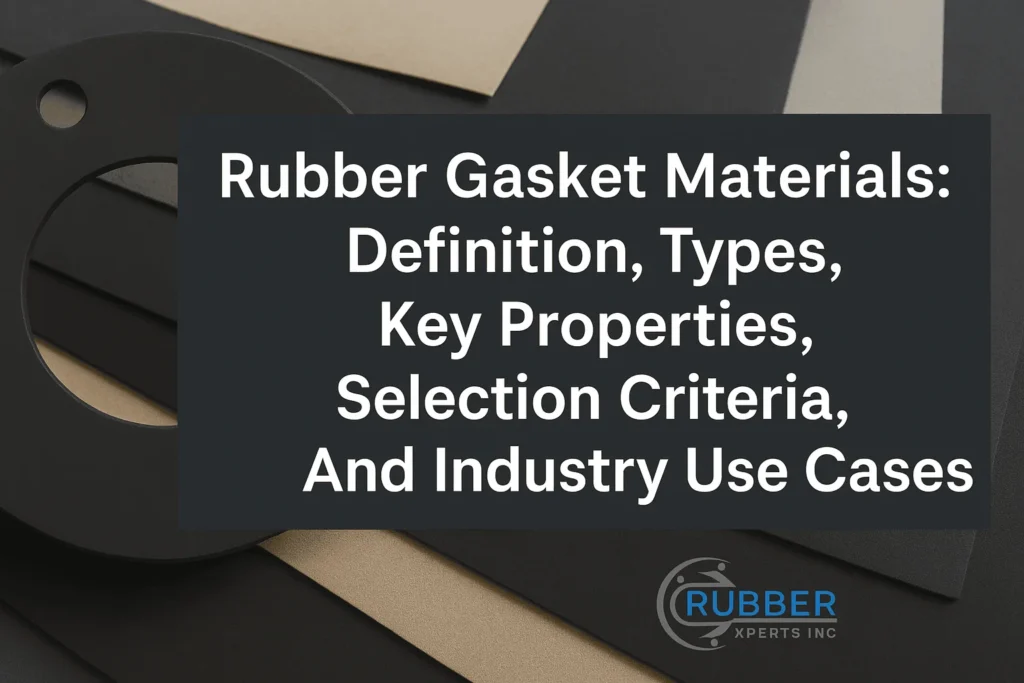Rubber hydraulic hoses are essential for transferring hydraulic fluid under high pressure in machinery and industrial systems. They enable fluid movement necessary to power equipment in construction, manufacturing, and heavy industries.
A study by Tubes International, “HydraulicRubberHosesandTheirApplications,” published in the HydraulicSystemsJournal (2021), states that rubber hoses provide superior flexibility and resistance to vibration, making them ideal for dynamic systems in industrial applications.
Rubber hydraulic hoses come in various types, including spiral wire-reinforced, braided wire, and textile-reinforced. Each type meets specific SAE, ISO, or DIN standards based on pressure requirements, temperature ranges, and resistance levels.
For example, SAE 100R1 and R2 hoses are widely used for medium—to high-pressure systems, while spiral-wound hoses, such as SAE 100R12, handle ultra-high-pressure demands in industrial environments.
The materials used in rubber hydraulic hoses consist of oil-resistant synthetic rubber for the inner tube, reinforced with layers of high-tensile steel wire or textile braid, and an abrasion-resistant outer cover.
According to a study by Gates Corporation titled “Hose Construction and Material Compatibility,” published in Hydraulic Technology Review (2019), the quality of materials directly influences a hose’s ability to resist leaks, withstand extreme pressures, and endure harsh environments.
Rubber hydraulic hoses are used in industrial and construction applications, powering heavy-duty equipment like excavators, cranes, and loaders.
According to a study by Hebei Qianli Rubber Products Co. titled “High-Pressure Hydraulic Hoses in Heavy Industries,” published in Industrial Hose Applications (2020), rubber hoses perform reliably in demanding environments.
The proper maintenance of hydraulic hoses includes regular inspections for abrasions, leaks, and wear, which are needed to extend the hose lifespan.
According to a report by NIOSH titled “Maintenance Practices for Hydraulic Systems,” published in Occupational Safety Review (2018), poor maintenance causes over 50% of hydraulic hose failures, showing the need for preventive care.
What Are Rubber Hydraulic Hoses?
Rubber hydraulic hoses are flexible, high-strength hoses designed to transfer hydraulic fluid under pressure, ensuring seamless operation in hydraulic systems.
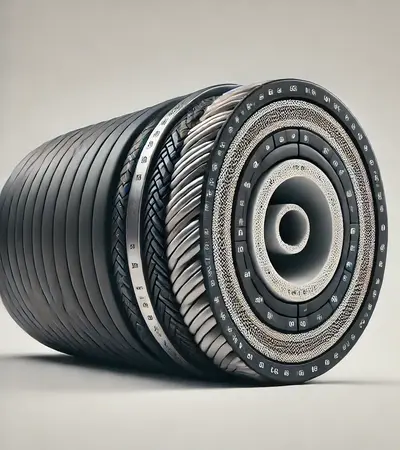
These hoses are constructed with an oil-resistant synthetic rubber inner tube, a reinforcement layer made of braided or spiral steel wires, and an abrasion-resistant outer cover.
This multi-layer design enables them to endure extreme pressure while remaining flexible and durable, even in challenging environments.
Rubber hydraulic hoses are made of materials such as high-tensile steel wire and synthetic elastomers, which provide exceptional resistance to heat, chemicals, and mechanical wear.
According to a study by Hebei Qianli Rubber Products Co. titled “High-Pressure Hydraulic Hoses in Heavy Industries,” published in Industrial Hose Applications (2020), rubber hydraulic hoses can operate within a pressure range of up to 4,000 psi and withstand temperatures from -40°C to 100°C.
Widely used in construction and industrial applications, rubber hydraulic hoses efficiently transfer hydraulic fluid to power machinery such as excavators, cranes, and loaders.
They also maintain the performance of high-pressure systems by ensuring fluid movement for lifting, steering, and braking operations.
What Are the Different Types of Hydraulic Hoses?
Hydraulic hoses come in various types, such as braided hoses for medium-pressure applications and spiral-wire hoses for high-pressure systems.
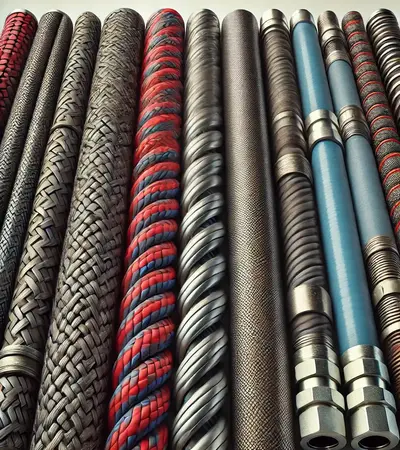
These heavy-duty rubber hoses differ in construction, pressure capabilities, and applications, ensuring they meet the demands of specific industrial and construction tasks.
The different types of hydraulic hoses are:
- Braided Hydraulic Hoses: These hoses feature one or two layers of braided steel wire reinforcement, providing flexibility and strength for medium-pressure systems. Braided hoses, such as SAE 100R1 and SAE 100R2, are commonly used in machinery like forklifts, loaders, and smaller hydraulic systems where moderate pressure and compact routing are required. According to a study by Tubes International titled “Hydraulic Rubber Hoses and Their Construction,” published in Fluid Systems Technology (2021), braided hoses handle working pressures of up to 3,500 psi and offer excellent vibration resistance.
- Spiral-Wire Hydraulic Hoses: These hoses are reinforced with multiple layers of spiral steel wires, offering superior strength and durability for high-pressure applications. Spiral-wire hoses, such as SAE 100R12 and SAE 100R13, are commonly used in heavy-duty equipment, including excavators, cranes, and mining machinery. They are designed to withstand working pressures exceeding 6,000 psi and are ideal for environments where shock loading and pressure surges occur.
- Non-Armored Hydraulic Hoses: Non-armored hoses are lightweight and flexible, suitable for low-pressure applications such as return lines, fuel systems, and water-based hydraulic systems. Hoses like SAE 100R3 feature textile reinforcement instead of wire, offering moderate strength and ease of installation in non-demanding conditions.
What is a Spiral Wire Reinforced Hydraulic Hose?
A spiral wire reinforced hydraulic hose is designed for high-pressure applications, featuring layers of spiraled wire that provide superior strength and resistance to internal pressure.
Unlike braided hoses, spiral wire hoses use four to six spirally wound layers of high-tensile steel wire, enabling them to handle extreme hydraulic loads without compromising flexibility.
Spiral wire hoses are widely used in industrial-strength machinery, such as excavators, cranes, and mining equipment, where consistent hydraulic power is required under high-pressure conditions.
According to a study by Tubes International titled “Hydraulic Rubber Hoses and Their Construction,” published in Fluid Systems Technology (2021), spiral-wire hoses such as SAE 100R12 and SAE 100R13 can withstand pressures of up to 6,000 psi, making them necessary for hydraulic systems operating in extreme environments.
Scientific tests conducted by Hebei Qianli Rubber Products Co. titled “High-Pressure Hydraulic Hoses in Heavy Industries,” published in Industrial Hose Applications (2020), confirm that spiral-wire hoses demonstrate a burst pressure four times their working pressure, ensuring reliability and safety in critical hydraulic operations.
What Are the Applications of Rubber Hydraulic Hoses?
Rubber hydraulic hoses are used in applications requiring high-pressure fluid transfer, such as in heavy machinery, construction equipment, and agricultural machinery. Their durability, flexibility, and ability to withstand extreme pressures make them indispensable across industries.
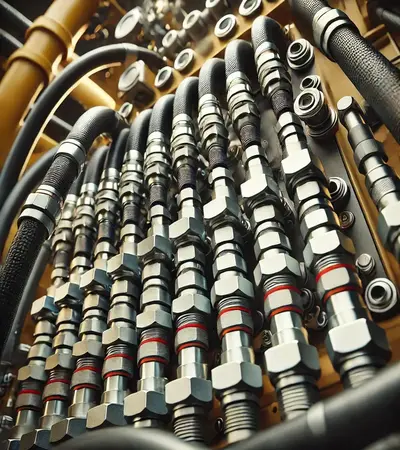
The key applications of rubber hydraulic hoses are:
- Construction Equipment: Rubber hydraulic hoses power heavy machinery like excavators, cranes, and bulldozers, which enable the movement of hydraulic arms, steering, and lifting mechanisms.
- Agricultural Machinery: Rubber hydraulic hoses are necessary for tractors, plows, and harvesters, where they operate lifting attachments, braking systems, and hydraulic steering. Their flexibility and abrasion resistance allows them to endure harsh agricultural environments, including exposure to soil and temperature extremes.
- AutomotiveSystems: Rubber hydraulic hoses are used in braking systems, power steering, and suspension components in the automotive industry. They ensure efficient hydraulic fluid transfer for critical operations like smooth braking and responsive steering.
What are the Construction Features of Rubber Hydraulic Hoses?
Rubber hydraulic hoses are constructed with multiple layers, including a rubber inner tube, a reinforcing layer, and an outer cover. These layers provide strength, durability, and resistance to environmental factors, ensuring reliable performance in high-pressure hydraulic systems.
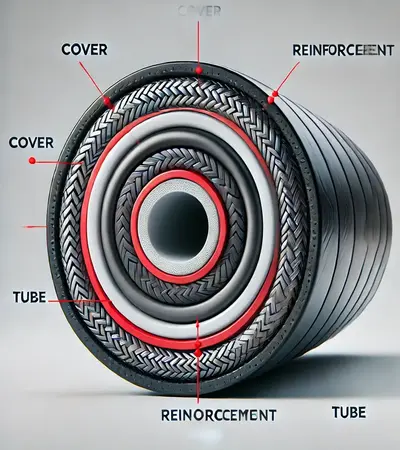
The inner tube is made of oil-resistant synthetic rubber, which ensures compatibility with hydraulic fluids and minimizes internal wear.
According to a study by Tubes International titled “Hydraulic Rubber Hoses and Their Construction,” published in Fluid Systems Technology (2021), the inner tube maintains its integrity under fluid pressures of up to 6,000 psi, preventing fluid leaks and ensuring efficient fluid transmission.
The reinforcing layer, consisting of braided or spiral-wound steel wire, provides the hose with the structural strength needed to endure extreme pressures. Braided hoses are ideal for medium-pressure systems, while spiral-wound hoses handle ultra-high pressures.
The outer cover is made from abrasion—and weather-resistant synthetic rubber. It protects the hose against external factors like heat, UV exposure, and chemicals, ensuring its longevity, particularly in outdoor and industrial applications.
A study by Gates Corporation titled “Introduction to Hydraulic Hose and Fittings,” published in Hydraulics 201 (2017), notes that advanced rubber outer covers improve resistance to abrasion by up to 25%, extending service life in harsh environments.
What are some Rubber Hydraulic Hose Fittings?
Below is a list of hydraulic hose fittings used to ensure secure and efficient connections in hydraulic systems:
- Crimp Fittings: Crimp fittings are permanently attached to hydraulic hoses using a crimping machine, creating a secure and leak-proof connection. They are ideal for high-pressure systems, ensuring durability and performance in demanding environments.
- ReusableFittings: Reusable fittings, also known as field-attachable fittings, are manually installed and removed without special tools. They are handy for emergency repairs or low-pressure applications and offer cost efficiency by extending the life of hoses.
- Quick Disconnects: Quick disconnect fittings allow hoses to be connected or disconnected rapidly without fluid loss, making them ideal for applications requiring frequent changes.
- Adapters: Adapters connect hoses of different sizes, threads, or configurations, ensuring compatibility within hydraulic systems. These fittings improve versatility by enabling integration across various components and systems.
- SwivelJoints: Swivel joints allow rotational movement, reducing stress on hoses caused by twisting or bending. They are widely used in dynamic applications, particularly in machinery with moving parts, to extend hose life and maintain system flexibility.
Are Some Rubber Hydraulic Hose Fittings Reusable?
Yes, there are two types of reusable rubber hydraulic hose fittings: field-installable fittings and threaded repair fittings. These fittings are installed without specialized crimping tools, making them ideal for on-site repairs or emergency replacements in hydraulic systems.
Field-installable fittings, such as SAE 100R7 reusable fittings, are designed for thermoplastic hoses and provide a secure, leak-proof connection without requiring permanent crimping.
According to a study by Gates Corporation titled “Introduction to Hydraulic Hose and Fittings,” published in Hydraulics 201 (2017), these reusable connectors withstand pressures of up to 3,000 psi, making them suitable for medium-pressure applications while offering flexibility during installation and repairs.
Threaded repair fittings and swivel fittings are another category of reusable connectors. These fittings are designed for repeated use, as they are removed and reattached to hoses multiple times.
Their robust design allows them to maintain a reliable seal, minimizing the risk of hydraulic fluid leaks in critical systems. Reusable repair fittings are primarily used in low to medium-pressure applications and extend the service life of hydraulic assemblies, reducing replacement costs.
How Do You Maintain Hydraulic Hoses?
Regular maintenance of hydraulic hoses involves checking for leaks, wear, and correct pressure ratings. Proper upkeep extends the lifespan of hydraulic hoses, minimizes failures, and ensures operational safety in high-pressure systems.
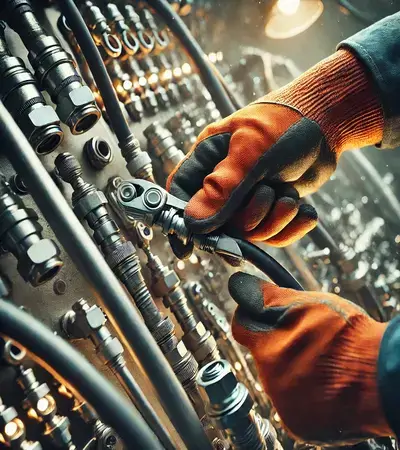
The ways to maintain hydraulic hoses are explained below:
- Visual Inspections: Regular visual inspections help identify signs of wear, such as abrasions, cracks, or leaks. According to a report by NIOSH titled “Maintenance Practices for Hydraulic Systems,” published in Occupational Safety Review (2018), over 50% of hydraulic hose failures result from undetected surface damage during visual inspections, underscoring the importance of routine checks.
- PressureTesting: Periodic pressure testing ensures that hoses handle their designated operating pressures without leaks or deformities. Research from Gates Corporation, “IntroductiontoHydraulicHoseandFittings,” published in Hydraulics201 (2017), states that hydraulic hoses must withstand up to four times their working pressure during burst tests to confirm durability and safety.
- Cleaning Procedures: Cleaning hydraulic hoses removes internal contaminants that degrade the hose material or damage the hydraulic system.
- Correct Pressure Ratings: Verifying that hoses are used within their specified pressure ratings prevents overloading, which causes sudden failures. Using hoses like SAE 100R1 and R2 in the appropriate pressure ranges improves system safety and prolongs hose service life.
- ProperStorage: Hydraulic hoses should be stored in a clean, cool environment, away from sunlight and corrosive chemicals, to prevent premature degradation.
What Safety Precautions Should Be Taken with Hydraulic Hoses?
Safety precautions when using hydraulic hoses include wearing protective gear, ensuring proper hose installation, and regularly inspecting hoses for damage.
Implementing these measures is relevant to preventing injuries and ensuring the safe operation of hydraulic systems under high pressure.
The safety precautions that should be taken with hydraulic hoses are explained below:
- WearingProtectiveGear: Personal protective equipment (PPE), including gloves, safety goggles, and protective clothing, minimizes the risk of hydraulic fluid injection injuries caused by pinhole leaks.
According to an OSHA report titled “HydraulicSystemsandInjuryPrevention,” published in the SafetyStandardsJournal (2019), pinhole leaks eject hydraulic fluid at speeds of up to 600 feet per second, causing severe tissue damage if skin exposure occurs.
- Ensuring Proper Hose Installation: Correct hose routing, secure couplings, and adherence to pressure ratings prevent premature failures. Improper installation, such as twisting or bending beyond the minimum bend radius, reduces hose lifespan and increases the likelihood of failure.
- Regular Inspections for Damage: Conducting routine visual inspections helps detect abrasions, cracks, or bulges that signal hose deterioration. A study by NIOSH titled “Maintenance Practices for Hydraulic Systems,” published in Occupational Safety Review (2018), states that undetected surface wear accounts for 30% of hose failures, emphasizing the importance of consistent inspections.
What Are the Risks of Hydraulic Hose Leaks?
Hydraulic hose leaks, especially under high pressure, cause severe injuries due to pinhole leaks or ruptures. High-pressure leaks eject hydraulic fluid at tremendous force, penetrating the skin and leading to serious tissue damage, infections, and, in severe cases, amputation or death.
According to a report by OSHA titled “Hydraulic Systems and Injury Prevention,” published in the Safety Standards Journal (2019), hydraulic fluid is ejected at pressures exceeding 6,000 psi and at speeds of up to 600 feet per second, making pinhole leaks particularly dangerous.
Beyond injury risks, hydraulic hose leaks reduce system efficiency by causing fluid loss, pressure drops, and contamination.
Leaking systems experience performance degradation, leading to increased energy consumption and unplanned downtime.
What Is the Number One Injury with Hydraulic Systems?
Hydraulic pinhole injuries occur when high-pressure hydraulic fluid escapes through tiny holes in hoses, leading to serious injury.
These pinhole leaks eject hydraulic fluid at such high velocity that it penetrates the skin, causing severe tissue damage, infections, or amputations if left untreated.
Hydraulic pinhole injuries are exacerbated in high-pressure systems where operating pressure exceeds 6,000 psi. Workers who unknowingly check for leaks using their bare hands are at the highest risk.
A study by NIOSH, “MaintenancePracticesforHydraulicSystems,” published in OccupationalSafetyReview (2018), shows that over one in 600 hydraulic hose failures results in a fluid injection injury.
How Do Hydraulic Hose Failures Lead to Injury?
Hydraulic hose failures, such as leaks or ruptures, result in pinhole injuries where high-pressure fluid escapes and punctures the skin. These injuries occur when hydraulic hoses weaken due to improper maintenance, aging, or incorrect installation.
Pinhole leaks can eject hydraulic fluid at speeds exceeding 600 feet per second, penetrating the skin and causing tissue damage that requires immediate medical intervention. Improper maintenance remains one of the most common causes of hydraulic hose failures.
A report by NIOSH titled “MaintenancePracticesforHydraulicSystems,” published in the OccupationalSafetyReview (2018), states that 50% of hydraulic hose failures result from undetected surface abrasions, wear, or misalignment. These weaknesses lead to structural weaknesses that increase the likelihood of leaks and ruptures.
Aging hoses also pose huge risks. Over time, exposure to heat, pressure cycles, and environmental factors causes material degradation, which results in cracks and bulging.
Hydraulic hoses that exceed their service life are more likely to rupture under pressure, raising the risk of high-pressure fluid leaks.
How Are Hydraulic Hoses Tested for Safety?
Hydraulic hoses are tested for pressure resistance and durability through hydrostatic and pneumatic tests. These methods ensure the hoses withstand operating conditions without leaks or failures, which is critical for safety in high-pressure systems.
Testing processes evaluate strength, wear resistance, and overall reliability to prevent accidents caused by hose ruptures or leaks.
Hydrostatic testing involves subjecting the hose to a controlled pressure that exceeds its maximum working pressure to verify its structural integrity.
According to a study titled “High-Pressure Hydraulic Hoses in Heavy Industries” (2020), hydraulic hoses are tested at 1.5 to 2 times their working pressure to ensure they do not deform or burst under stress. This test identifies weak spots or manufacturing defects that compromise safety during operation.
Pneumatic testing uses compressed air or gas to detect leaks and verify the hose’s ability to maintain pressure without fluid loss. It is performed at lower pressures to safely check for micro-leaks, which are a leading cause of gradual system inefficiencies.
What Are Considerations for Selecting Hydraulic Hoses?
Below is a list of key factors for selecting the right hydraulic hose to ensure safe and effective operation in hydraulic systems:
- Pressure Rating: Hydraulic hoses must match the system’s operating pressure to avoid leaks and bursts. Hoses like SAE 100R12 are rated for pressures up to 4,000 psi, making them suitable for high-pressure industrial systems.
- Material Compatibility: The hose material must be compatible with the hydraulic fluid to prevent chemical degradation and internal wear. Incompatibility with petroleum-based or phosphate-ester fluids can reduce hose lifespan.
- Temperature Tolerance: Hydraulic hoses must withstand both fluid and ambient temperatures without hardening, cracking, or losing flexibility. Standard rubber hoses tolerate temperatures from -40°C to 100°C, while specialty hoses endure extremes up to +260°C.
- Application Environment: Factors such as abrasion, UV exposure, and mechanical stress in the operating environment determine the hose’s outer cover and reinforcement layer.
Choosing the right hydraulic hose based on pressure rating, material compatibility, temperature tolerance, and application environment ensures safety, longevity, and reliable performance in hydraulic systems. Proper selection also reduces downtime, minimizes risks, and maximizes efficiency in demanding applications.
How Do Hydraulic Hoses Resist Wear and Tear?
Hydraulic hoses are designed with reinforced materials, such as spiral wires, to resist wear, tear, and high pressure. These reinforcements and durable outer layers enable hoses to withstand abrasive environments, extreme pressures, and mechanical stress, ensuring longevity and reliable operation in demanding applications.
The hose material plays a relevant role in durability. The inner tube, made of oil-resistant synthetic rubber, prevents internal wear caused by hydraulic fluid flow. According to a study titled “Hydraulic Rubber Hoses and Their Applications,” published in Fluid Systems Technology (2021), hoses with advanced synthetic rubber compounds exhibit 30% higher resistance to chemical and oil-related degradation, extending their lifespan under constant hydraulic fluid exposure.
The reinforcement layers, such as braided steel wire or spiral-wound wires, contribute to high-pressure durability and structural strength. Spiral-wire reinforced hoses endure pressures exceeding 6,000 psi while maintaining flexibility, making them ideal for high-stress industrial environments. These reinforcements ensure the hose remains intact under repeated pressure cycles, minimizing the risk of ruptures.
The outer cover protects the hose from external abrasions, UV exposure, and environmental factors. Hoses with abrasion-resistant covers are specifically designed to endure contact with rough surfaces, reducing damage over time.
What Are the Causes of Hydraulic Hose Failure?
Hydraulic hose failure can be caused by factors like high pressure, temperature extremes, abrasion, chemical exposure, or improper installation. These factors accelerate hose degradation, reduce system efficiency, and increase the risk of catastrophic failures in high-pressure applications.
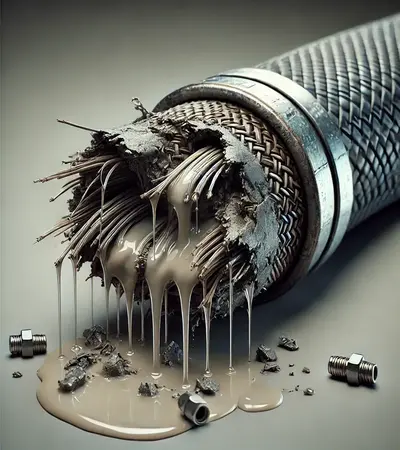
High pressure is one of the leading causes of hydraulic hose failure. When a hose operates at pressures exceeding its rating, it ruptures or develops pinhole leaks. Selecting hoses with appropriate pressure ratings ensures safe operation.
Temperature extremes, both high and low, degrade hose materials over time. Excessive heat causes the inner tube to harden and crack, while extreme cold reduces flexibility, leading to fractures.
Abrasion from external contact with rough surfaces also accelerates wear on the hose’s outer cover, compromising its structural integrity. Installing hose guards or using abrasion-resistant covers extends the hose lifespan.
Chemical exposure deteriorates the inner tube and outer cover, especially when hoses are incompatible with the hydraulic fluid being used. Ensuring material compatibility with hydraulic fluids, such as phosphate ester-based or petroleum-based fluids, is necessary for longevity.
Improper installation, such as exceeding the minimum bend radius, twisting hoses, or poorly routed lines, puts undue stress on hoses.
A report by NIOSH titled “Maintenance Practices for Hydraulic Systems,” published in Occupational Safety Review (2018), emphasizes that improper installation increases the risk of failure by 60%, particularly in high-pressure systems.
How Do You Prevent Hydraulic Hose Failures?
Preventing hydraulic hose failures involves regular inspections, replacing worn hoses, and ensuring hoses are properly installed and maintained. Implementing these practices reduces the risk of system downtime, injuries, and costly failures in high-pressure hydraulic systems.
The ways to prevent hydraulic hose failures are explained below:
- Regular Inspections: Conducting routine visual inspections is necessary for detecting signs of wear, abrasions, or leaks before they escalate. Operators must focus on checking for cracks, bulges, and fluid seepage at fittings.
- Replacing Worn Hoses: Hoses nearing the end of their service life must be replaced promptly to avoid catastrophic failure. Using high-quality replacements compatible with system pressure and fluid type ensures long-term reliability.
- Proper Installation and Routing: Ensuring hoses are correctly installed and routed prevents undue stress on the hose assembly. Improper routing, such as exceeding the minimum bend radius or twisting the hose, accelerates wear and increases failure risks. A study by Gates Corporation titled “Introduction to Hydraulic Hose and Fittings,” published in Hydraulics 201 (2017), highlights that following routing guidelines reduces failure rates by 60%, particularly in systems under constant pressure cycles.
- Use of Protective Guards and Sleeves: Installing hose guards or protective sleeves helps shield hoses from external abrasion, heat, and environmental damage.
- Training and Safety Protocols: Providing operators with proper training on hydraulic system maintenance and safety reduces the risk of injuries. Workers must also be trained to avoid direct contact with pressurized hoses and use protective equipment during inspections.

